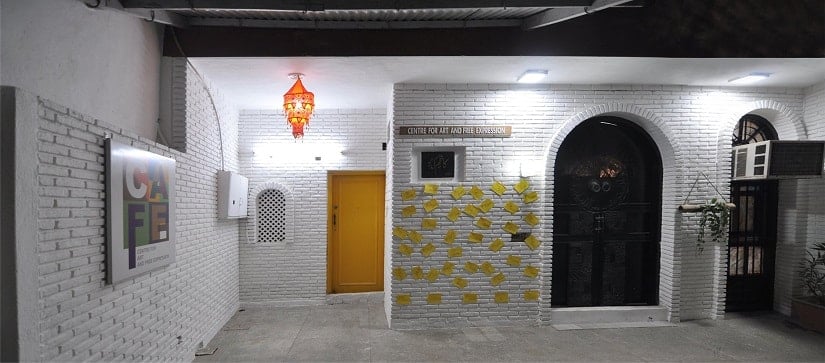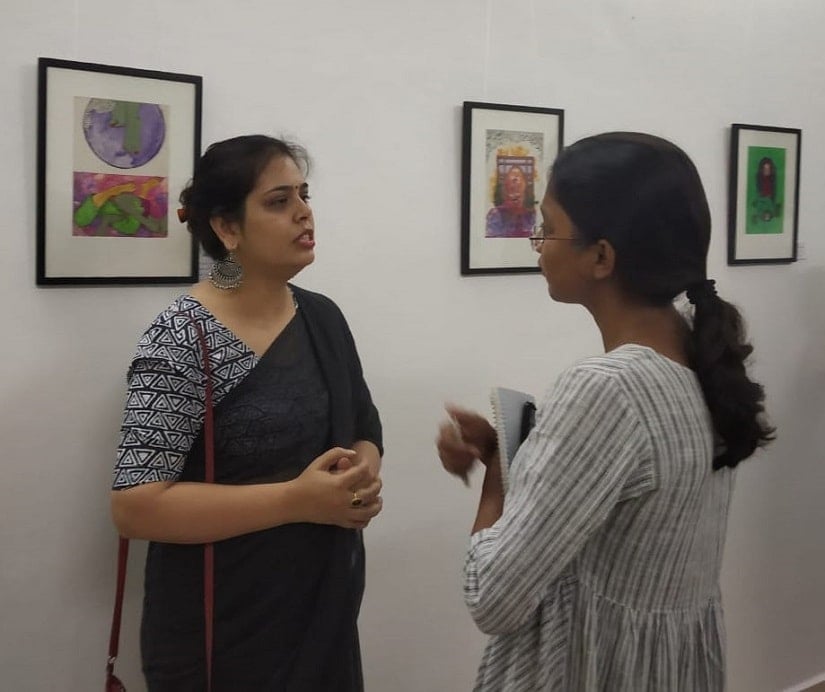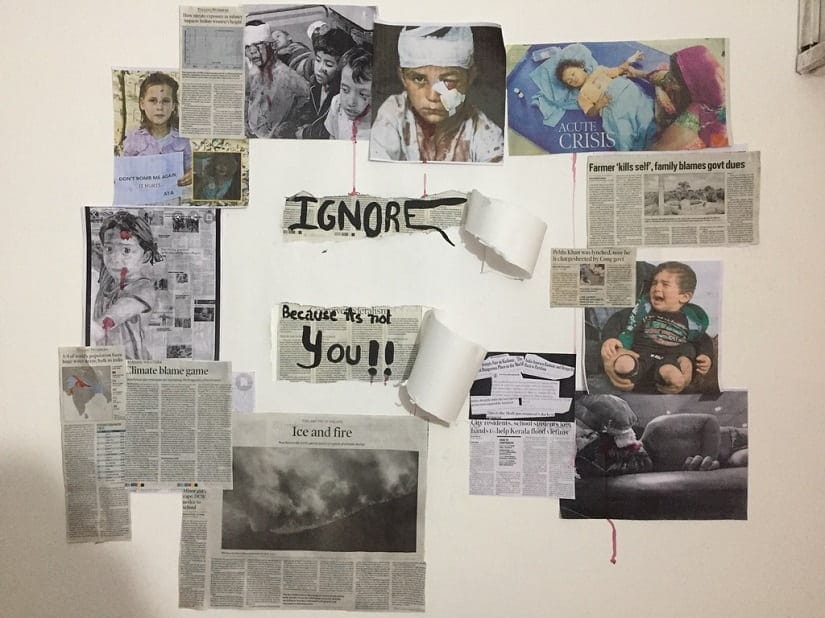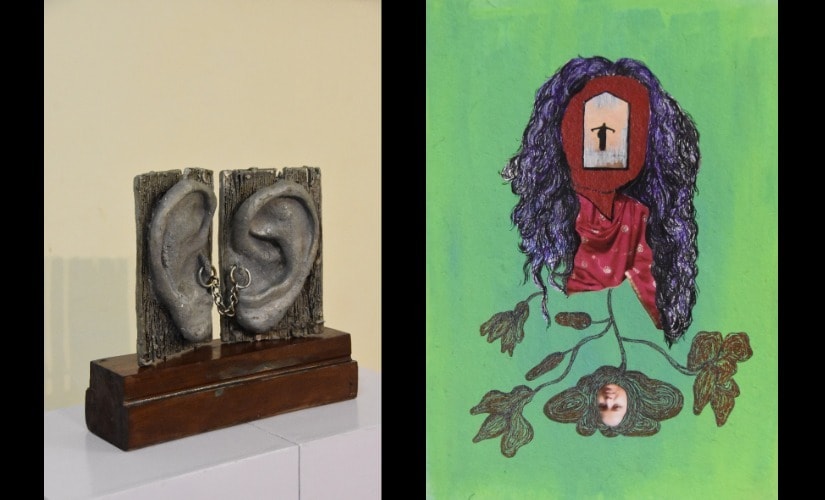Tucked away in a congested south Delhi neighbourhood, Gallery Magenta is anything but a typical big city art space. It does not host elaborate opening previews, where wine and finger food are generously served. On a Saturday evening as I navigated my way through the maze of Jamia Nagar, I reached the dead end of a narrow street, where the gallery is located. As I opened its yellow door, I was greeted by a group of women having tea and biscuits. The atmosphere was relaxed, snug like a home. The women were sitting on the floor, talking to each other. The hall did not have too many people though. Other than being late for the opening, I felt somewhat out of place, since I am used to attending pretentious preview evenings. [caption id=“attachment_7335731” align=“alignnone” width=“825”]  Cafe Jamia in New Delhi[/caption] Soon, Rabab Zaidi, curator of the gallery, came to my rescue. She took me to the first floor, where her new exhibition was mounted. It turned out that that building is her family home, which has been converted into Café Jamia, short for the Centre for Art and Free Expression. The centre, which also hosts the gallery, was started by Zaidi and her journalist brother Bilal in 2017, with the aim to establish a safe platform for presenting different forms of creative arts in a minority-dominated neighbourhood. The centre hosts lectures, musical evenings, discussions and art exhibitions. One of its most recent events was a guest lecture by Reuters photojournalist Danish Siddiqui, who along with his colleague Adnan Abidi, was the recipient of the 2018 Pulitzer Prize for their reportage of the Rohingya crisis. In a strange coincidence, Café Jamia’s latest exhibition was inaugurated a day before 100,000 Rohingya refugees, who are largely Muslims, observed the two-year anniversary of a military-led crackdown that forced them to leave their homes in Myanmar. Zaidi’s curatorial note, with its focus on the disenfranchisement of minority voices, resonated with the ‘Rohingya Genocide Remembrance’, which was observed in relief camps in Bangladesh. “We are living in times where the voices of those on the margins are often drowned under direct or indirect influences. These are not just the voices of minorities, but voices of any individual or group that is struggling to get heard – Gallery Magenta aims to be a platform for their expression,” the curator wrote in her introduction to the show. The exhibition, titled “Green Shoots in the Neighbourhood”, is the art collective’s attempt to interrogate the perception of a Muslim ghetto that has been associated with Jamia Nagar. It was open for public viewing during the last week of August. [caption id=“attachment_7335751” align=“alignnone” width=“825”]  Curator Rabab Zaidi at the opening of Green Shoots in the Neighbourhood exhibition at Cafe Jamia[/caption] Café Jamia is not very far from Batla House, which has been in the national spotlight since a controversial police encounter took place in 2008. On the lookout for alleged terrorists, the Delhi Police team raided a flat in Batla House, which led to the killing of a police inspector and two men who were living in the house, following an exchange of firing. While many journalists, politicians and civil society groups questioned the strategy and execution of the encounter, calling it “fake”, the raid was also seen as a trigger behind the rise of religion-based stereotyping and discrimination against Muslims. While the encounter may have faded from public memory, there remains a sense of isolation in Jamia Nagar, which witnessed migration of a large number of Muslims after incidents of religion-based violence in India, such as the 1984 anti-Sikh riots; clashes following the Babri Masjid demolition in 1992; and the Godhra riots. “Muslims saw a pattern during the anti-Sikh riots in and around Delhi — that those who lived together in clusters were less persecuted,” explained student Towfeeq Wani in an article titled “How Jamia Nagar became a Muslim ghetto”, which was published on the Youth Ki Awaaz website. It is against this backdrop that Rabab Zaidi’s exhibition is relevant, especially because of renewed concerns against persecution of minorities in the country — a worrying phenomenon that has been linked with the resurgence of right-wing majoritarianism. Putting together a diverse collection of sculptures, paintings, drawings, archival material and collages, the exhibition gives voice to young artists living in Jamia Nagar, which is home to a fine arts department under the Jamia Millia Islamia University. The five participating artists are Tehmeena Firdous, Reshma Khatoon and Sitara Khan, who are alumnae of the fine arts faculty, like Zaidi; and Kauser Jahan and Kulsoom Khan, currently studying at the department. [caption id=“attachment_7335721” align=“alignnone” width=“825”]  Kauser Jahan, untitled collage[/caption] As I walked up to the first floor of the gallery, the first artwork, by Kauser Jahan, that caught my attention was a large collection of newspaper clippings pasted on the wall. Pictures of children, seriously injured in a conflict or suffering from an illness, stood out in the collage. It also showed news clippings on climate change, farmer suicides, Kerala floods, and the government’s decision to end Jammu and Kashmir’s special status. “India annexes Kashmir and brings us back to Partition,” read one of the headlines in the collage. Right below the collage is an aluminum sculpture showing two large ears, joined by a fetter. Can voices of protest be ignored? And for how long? Through her sculpture, Jahan asks these questions. As part of a collection of paintings by Reshma Khatoon, a water colour work shows a miniature woman standing inside a hijab-like form. Her tiny silhouette shows she is in a jovial mood, suggesting the possibility of freedom despite following traditional customs such as wearing the hijab. Another water colour painting by Khatoon shows a protest being led by a group of women on the Jamia campus. [caption id=“attachment_7335701” align=“alignnone” width=“825”]  (L) Kauser Jahan, Rustle Senses, aluminium sculpture. (R) Reshma Khatoon, untitled, watercolour.[/caption] Student protests are common at the university. Earlier this year, students demanded the suspension of Hafeez Ahmad, the Fine Arts department head, over allegations of sexual harassment. In a separate incident, a fashion show and dice game at the university were cancelled following protests by students, who said the events were “against Islamic ethics”. Given the local context, the exhibition sought to imply that the conflict is not only between the “ghetto” and what lies outside of it, the schism also exists within it. Feminist identity, body politics, skin colour-based discrimination and the side-effect of technology on human interaction are some of the other themes explored in this exhibition. In India, however, there is a dearth of exhibitions that focus on works by artists from the minority community. This, despite the fact that alternative spaces, like the Irregulars Art Fair, that want to challenge the mainstream art world have begun to get noticed. Because Café Jamia is also one such initiative, it may have to step out of the shadow of its informal and homegrown setup in order to be seen and heard by a wider audience. Part of that transition might also involve renouncing the ghetto tag, without diluting its raison d’être.
Tucked away in a congested south Delhi neighbourhood, Gallery Magenta in Jamia Nagar is anything but a typical big city art space. It does not host elaborate opening previews, where wine and finger food are generously served.
Advertisement
End of Article


)
)
)
)
)
)
)
)
)



